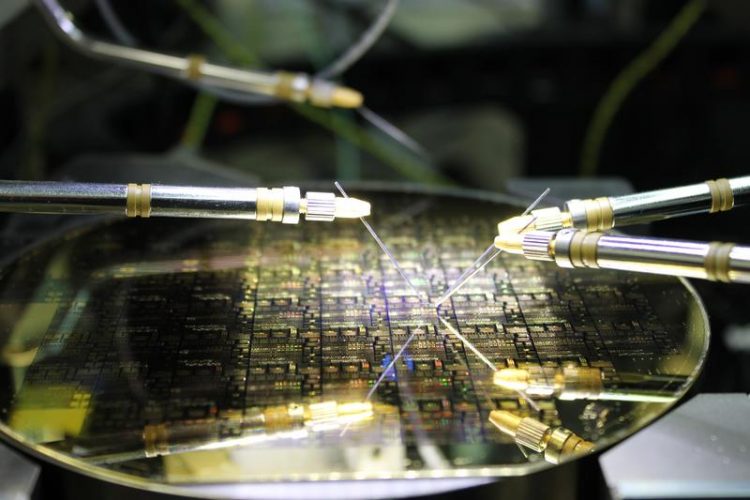In best circles: First integrated circuit from self-assembled polymer

The scientists made an IC from a monolayer of a semiconducting polymer. Copyright: MPI for Polymer Research
In the self-assembly process, the semiconducting polymer arranges itself into an ordered monolayer in a transistor. The transistors are binary switches used for logic operation in digital circuits and are the building blocks of an integrated circuit. The radical concept of self-assembled electronics has been around since 1976. For decades, the challenge has been to form a self-assembled monolayer of a semiconducting polymer in a transistor.
“The idea is that all components of a transistor come together and arrange themselves in a hierarchical order”, said Kamal Asadi, leader of the Humboldt research group at the MPI for Polymer Research. The monolayer is highly ordered and is able to conduct electric charge carriers well. The research team has used solution of a polymer. By dipping the transistor substrate in the solution in a controlled manner, the researchers could grow and produce a complete polymeric monolayer.
Scientific breakthrough
To achieve their scientific breakthrough, the scientists have intentionally dissolved the semiconducting polymer in an organic solvent that could not fully dissolve the polymer. In this way, the scientists have made the first self-assembled monolayer polymer field-effect transistor (PoM-FET). Nevertheless, one PoM-FET does not make a functional integrated circuit.
Therefore, the research team has integrated hundreds of PoM-FETs and has operated them at the same time to demonstrate a 15-bit code generator, an integrated circuit that converts a voltage into a digital code. The landmark scientific result has applications in flexible electronics and fast response sensors.
International research collaboration
The scientific work was a collaboration of several international research groups worldwide. The semiconducting polymer was synthesized by the group of Professor He Yan at the Hong Kong University of Science and Technology, Hong Kong. The polymeric monolayers were analyzed by the group of Professor Harald Ade at the North Carolina State University in USA, and by the group of Professor Wojtek Pisula at the Lodz University of Technology, Poland. The PoM-FETs and the integrated circuits were fabricated at the MPI for Polymer Research, Mainz, Germany. Post-doctoral researcher Mengmeng Li conducted the research work that was led by Kamal Asadi together with Wojtek Pisula.
About the Max Planck Institute for Polymer Research
The Max Planck Institute for Polymer Research (MPI-P) ranks among the globally leading research centers in the field of polymer research since its foundation in 1984. The focus on soft materials and macromolecular materials has resulted in the worldwide unique position of the MPI-P and its research focus. Fundamental polymers research on both production and characterization as well as analysis of physical and chemical properties are conducted by scientific collaborators from all over the world. Presently over 500 people are working at the MPI-P, the vast majority of whom are engaged in scientific research.
http://www.mpip-mainz.mpg.de/home/en
https://www.humboldt-foundation.de/web/home.html
Media Contact
All latest news from the category: Power and Electrical Engineering
This topic covers issues related to energy generation, conversion, transportation and consumption and how the industry is addressing the challenge of energy efficiency in general.
innovations-report provides in-depth and informative reports and articles on subjects ranging from wind energy, fuel cell technology, solar energy, geothermal energy, petroleum, gas, nuclear engineering, alternative energy and energy efficiency to fusion, hydrogen and superconductor technologies.
Newest articles

You are What You Eat—Stanford Study Links Fiber to Anti-Cancer Gene Modulation
The Fiber Gap: A Growing Concern in American Diets Fiber is well known to be an important part of a healthy diet, yet less than 10% of Americans eat the minimum recommended…

Trust Your Gut—RNA-Protein Discovery for Better Immunity
HIRI researchers uncover control mechanisms of polysaccharide utilization in Bacteroides thetaiotaomicron. Researchers at the Helmholtz Institute for RNA-based Infection Research (HIRI) and the Julius-Maximilians-Universität (JMU) in Würzburg have identified a…

ASXL1 Mutation: The Hidden Trigger Behind Blood Cancers and Inflammation
Scientists show how a mutated gene harms red and white blood cells. LA JOLLA, CA—Scientists at La Jolla Institute for Immunology (LJI) have discovered how a mutated gene kicks off…



